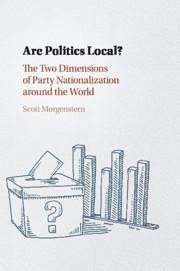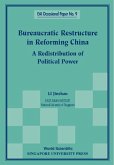Scott Morgenstern
Are Politics Local?
Scott Morgenstern
Are Politics Local?
- Broschiertes Buch
- Merkliste
- Auf die Merkliste
- Bewerten Bewerten
- Teilen
- Produkt teilen
- Produkterinnerung
- Produkterinnerung
This book asks: are politics local? Why? Where? How do we measure local versus national politics? And what are the effects?
Andere Kunden interessierten sich auch für
![Towards More Effective Governance: China's Politics in 1998 Towards More Effective Governance: China's Politics in 1998]() Yongnian ZhengTowards More Effective Governance: China's Politics in 199811,99 €
Yongnian ZhengTowards More Effective Governance: China's Politics in 199811,99 €![The Political Economy of Public Finance The Political Economy of Public Finance]() The Political Economy of Public Finance41,99 €
The Political Economy of Public Finance41,99 €![Lynching and Local Justice Lynching and Local Justice]() Danielle F JungLynching and Local Justice22,99 €
Danielle F JungLynching and Local Justice22,99 €![Learning and the Reform of Chinese Foreign Policy Learning and the Reform of Chinese Foreign Policy]() Lowell DittmerLearning and the Reform of Chinese Foreign Policy11,99 €
Lowell DittmerLearning and the Reform of Chinese Foreign Policy11,99 €![Bureaucratic Restructure in Reforming China: A Redistribution of Political Power Bureaucratic Restructure in Reforming China: A Redistribution of Political Power]() Jinshan LiBureaucratic Restructure in Reforming China: A Redistribution of Political Power11,99 €
Jinshan LiBureaucratic Restructure in Reforming China: A Redistribution of Political Power11,99 €![Gradual Economic Reform in Latin a Gradual Economic Reform in Latin a]() Mary a ClarkGradual Economic Reform in Latin a33,99 €
Mary a ClarkGradual Economic Reform in Latin a33,99 €![The Progressive Party in Canada The Progressive Party in Canada]() W L MortonThe Progressive Party in Canada49,99 €
W L MortonThe Progressive Party in Canada49,99 €-
-
-
This book asks: are politics local? Why? Where? How do we measure local versus national politics? And what are the effects?
Produktdetails
- Produktdetails
- Verlag: Cambridge University Press
- Seitenzahl: 312
- Erscheinungstermin: 10. Mai 2018
- Englisch
- Abmessung: 228mm x 154mm x 22mm
- Gewicht: 463g
- ISBN-13: 9781108400343
- ISBN-10: 1108400345
- Artikelnr.: 52613884
- Herstellerkennzeichnung
- Libri GmbH
- Europaallee 1
- 36244 Bad Hersfeld
- gpsr@libri.de
- Verlag: Cambridge University Press
- Seitenzahl: 312
- Erscheinungstermin: 10. Mai 2018
- Englisch
- Abmessung: 228mm x 154mm x 22mm
- Gewicht: 463g
- ISBN-13: 9781108400343
- ISBN-10: 1108400345
- Artikelnr.: 52613884
- Herstellerkennzeichnung
- Libri GmbH
- Europaallee 1
- 36244 Bad Hersfeld
- gpsr@libri.de
Scott Morgenstern is Professor of Political Science and Director of the Center for Latin American Studies at the University of Pittsburgh. He is author of Patterns of Legislative Politics: Roll Call Voting in the United States and Latin America's Southern Cone (Cambridge, 2004) and the co-editor of Legislative Politics in Latin America, (Cambridge, 2002), Pathways to Power (2008), and Reforming Communism: Cuba in Comparative Perspective (2017). His articles have appeared in the Journal of Politics, Comparative Political Studies, Comparative Politics, Party Politics, Electoral Studies, and other journals.
Part I. Describing, Measuring, and Comparing the Two Dimensions: 1.
Dimensions of party nationalization: static and dynamic; 2. A typology of
party nationalization; 3. Measuring static and dynamic nationalization; 4.
Applying the model: patterns of static and dynamic nationalization; Part
II. Explaining Party Nationalization; 5. Explaining static and dynamic
nationalization; 6. Institutions, ethnic heterogeneity and party
nationalization: a statistical analysis; Part III. Implications:
Nationalization as an Explanatory Variable: 7. Regionalism, accountability,
and party nationalization; 8. The role of party nationalization on party
unity and retrospective voting; 9. The role of party nationalization on
collective action and dissent among co-partisan legislators: roll call
voting and bill co-sponsorship; Part IV. Conclusion: 10. Summary and
Conclusions.
Dimensions of party nationalization: static and dynamic; 2. A typology of
party nationalization; 3. Measuring static and dynamic nationalization; 4.
Applying the model: patterns of static and dynamic nationalization; Part
II. Explaining Party Nationalization; 5. Explaining static and dynamic
nationalization; 6. Institutions, ethnic heterogeneity and party
nationalization: a statistical analysis; Part III. Implications:
Nationalization as an Explanatory Variable: 7. Regionalism, accountability,
and party nationalization; 8. The role of party nationalization on party
unity and retrospective voting; 9. The role of party nationalization on
collective action and dissent among co-partisan legislators: roll call
voting and bill co-sponsorship; Part IV. Conclusion: 10. Summary and
Conclusions.
Part I. Describing, Measuring, and Comparing the Two Dimensions: 1.
Dimensions of party nationalization: static and dynamic; 2. A typology of
party nationalization; 3. Measuring static and dynamic nationalization; 4.
Applying the model: patterns of static and dynamic nationalization; Part
II. Explaining Party Nationalization; 5. Explaining static and dynamic
nationalization; 6. Institutions, ethnic heterogeneity and party
nationalization: a statistical analysis; Part III. Implications:
Nationalization as an Explanatory Variable: 7. Regionalism, accountability,
and party nationalization; 8. The role of party nationalization on party
unity and retrospective voting; 9. The role of party nationalization on
collective action and dissent among co-partisan legislators: roll call
voting and bill co-sponsorship; Part IV. Conclusion: 10. Summary and
Conclusions.
Dimensions of party nationalization: static and dynamic; 2. A typology of
party nationalization; 3. Measuring static and dynamic nationalization; 4.
Applying the model: patterns of static and dynamic nationalization; Part
II. Explaining Party Nationalization; 5. Explaining static and dynamic
nationalization; 6. Institutions, ethnic heterogeneity and party
nationalization: a statistical analysis; Part III. Implications:
Nationalization as an Explanatory Variable: 7. Regionalism, accountability,
and party nationalization; 8. The role of party nationalization on party
unity and retrospective voting; 9. The role of party nationalization on
collective action and dissent among co-partisan legislators: roll call
voting and bill co-sponsorship; Part IV. Conclusion: 10. Summary and
Conclusions.









